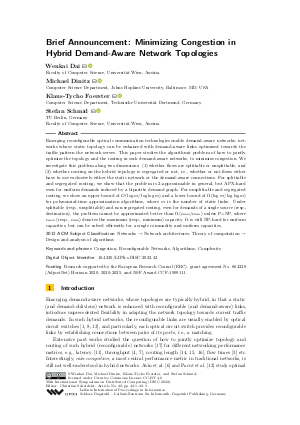Brief Announcement: Minimizing Congestion in Hybrid Demand-Aware Network Topologies
Authors
Wenkai Dai  ,
Michael Dinitz
,
Michael Dinitz  ,
Klaus-Tycho Foerster
,
Klaus-Tycho Foerster  ,
Stefan Schmid
,
Stefan Schmid 
-
Part of:
Volume:
36th International Symposium on Distributed Computing (DISC 2022)
Part of: Series: Leibniz International Proceedings in Informatics (LIPIcs)
Part of: Conference: International Symposium on Distributed Computing (DISC) - License:
 Creative Commons Attribution 4.0 International license
Creative Commons Attribution 4.0 International license
- Publication Date: 2022-10-17
File

PDF
LIPIcs.DISC.2022.42.pdf
- Filesize: 0.56 MB
- 3 pages
Document Identifiers
Subject Classification
ACM Subject Classification
- Networks → Network architectures
- Theory of computation → Design and analysis of algorithms
Keywords
- Congestion
- Reconfigurable Networks
- Algorithms
- Complexity
Metrics
- Access Statistics
-
Total Accesses (updated on a weekly basis)
0Document
0Metadata
Abstract
Emerging reconfigurable optical communication technologies enable demand-aware networks: networks whose static topology can be enhanced with demand-aware links optimized towards the traffic pattern the network serves. This paper studies the algorithmic problem of how to jointly optimize the topology and the routing in such demand-aware networks, to minimize congestion. We investigate this problem along two dimensions: (1) whether flows are splittable or unsplittable, and (2) whether routing on the hybrid topology is segregated or not, i.e., whether or not flows either have to use exclusively either the static network or the demand-aware connections. For splittable and segregated routing, we show that the problem is 2-approximable in general, but APX-hard even for uniform demands induced by a bipartite demand graph. For unsplittable and segregated routing, we show an upper bound of O(log m/ log log m) and a lower bound of Ω(log m/ log log m) for polynomial-time approximation algorithms, where m is the number of static links. Under splittable (resp., unsplittable) and non-segregated routing, even for demands of a single source (resp., destination), the problem cannot be approximated better than Ω(c_{max}/c_{min}) unless P=NP, where c_{max} (resp., c_{min}) denotes the maximum (resp., minimum) capacity. It is still NP-hard for uniform capacities, but can be solved efficiently for a single commodity and uniform capacities.
Cite As Get BibTex
Wenkai Dai, Michael Dinitz, Klaus-Tycho Foerster, and Stefan Schmid. Brief Announcement: Minimizing Congestion in Hybrid Demand-Aware Network Topologies. In 36th International Symposium on Distributed Computing (DISC 2022). Leibniz International Proceedings in Informatics (LIPIcs), Volume 246, pp. 42:1-42:3, Schloss Dagstuhl – Leibniz-Zentrum für Informatik (2022)
https://doi.org/10.4230/LIPIcs.DISC.2022.42
BibTex
@InProceedings{dai_et_al:LIPIcs.DISC.2022.42,
author = {Dai, Wenkai and Dinitz, Michael and Foerster, Klaus-Tycho and Schmid, Stefan},
title = {{Brief Announcement: Minimizing Congestion in Hybrid Demand-Aware Network Topologies}},
booktitle = {36th International Symposium on Distributed Computing (DISC 2022)},
pages = {42:1--42:3},
series = {Leibniz International Proceedings in Informatics (LIPIcs)},
ISBN = {978-3-95977-255-6},
ISSN = {1868-8969},
year = {2022},
volume = {246},
editor = {Scheideler, Christian},
publisher = {Schloss Dagstuhl -- Leibniz-Zentrum f{\"u}r Informatik},
address = {Dagstuhl, Germany},
URL = {https://drops.dagstuhl.de/entities/document/10.4230/LIPIcs.DISC.2022.42},
URN = {urn:nbn:de:0030-drops-172330},
doi = {10.4230/LIPIcs.DISC.2022.42},
annote = {Keywords: Congestion, Reconfigurable Networks, Algorithms, Complexity}
}
Author Details
Funding
Research supported by the European Research Council (ERC), grant agreement No. 864228 (AdjustNet) Horizon 2020, 2020-2025, and NSF Award CCF-1909111.
References
-
S. Aleksic. The future of optical interconnects for data centers: A review of technology trends. In 2017 14th International Conference on Telecommunications (ConTEL), June 2017.

-
W. Dai et al. Load-optimization in reconfigurable networks: Algorithms and complexity of flow routing. SIGMETRICS Perform. Evaluation Rev., 48(3), 2020.

-
M. Dinitz and B. Moseley. Scheduling for weighted flow and completion times in reconfigurable networks. In INFOCOM. IEEE, 2020.

-
A. Singla et al. High throughput data center topology design. In NSDI. USENIX, 2014.

-
B. Venkatakrishnan et al. Costly circuits, submodular schedules and approximate carathéodory theorems. In SIGMETRICS, 2016.

-
C. Avin et al. Demand-aware network design with minimal congestion and route lengths. In INFOCOM. IEEE, 2019.

-
D. Nikhil et al. Stable matching algorithm for an agile reconfigurable data center interconnect (MSR-TR-2016-1140). Technical report, Microsoft Research, June 2016.

-
G. Wang et al. c-through: part-time optics in data centers. In SIGCOMM. ACM, 2010.

-
H. Liu et al. Scheduling techniques for hybrid circuit/packet networks. In CoNEXT. ACM, 2015.

-
J. Zheng et al. Dynamic load balancing in hybrid switching data center networks with converters. In ICPP. ACM, 2019.

-
M. Ghobadi et al. Projector: Agile reconfigurable data center interconnect. In SIGCOMM. ACM, 2016.

-
M. Pacut et al. Improved scalability of demand-aware datacenter topologies with minimal route lengths and congestion. Perform. Evaluation, 152, 2021.

-
N. Farrington et al. Helios: a hybrid electrical/optical switch architecture for modular data centers. In SIGCOMM. ACM, 2010.

-
T. Fenz et al. Efficient non-segregated routing for reconfigurable demand-aware networks. Comput. Commun., 164, 2020.

-
K.-T. Foerster et al. On the complexity of non-segregated routing in reconfigurable data center architectures. Comput. Commun. Rev., 49(2):2-8, 2019.

-
K.-T. Foerster and S. Schmid. Survey of reconfigurable data center networks: Enablers, algorithms, complexity. SIGACT News, 50(2), 2019.

-
M. N. Hall et al. A survey of reconfigurable optical networks. Opt. Switch. Netw., 41, 2021.

- Vijay V. Vazirani. Approximation algorithms. Springer, 2001. URL: http://www.springer.com/computer/theoretical+computer+science/book/978-3-540-65367-7.
